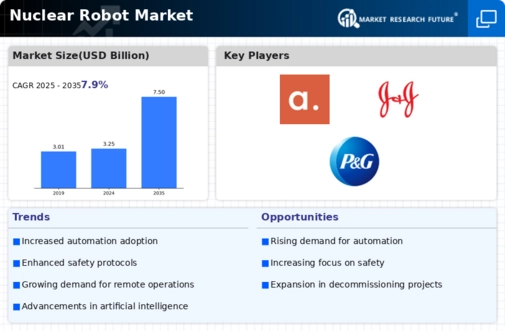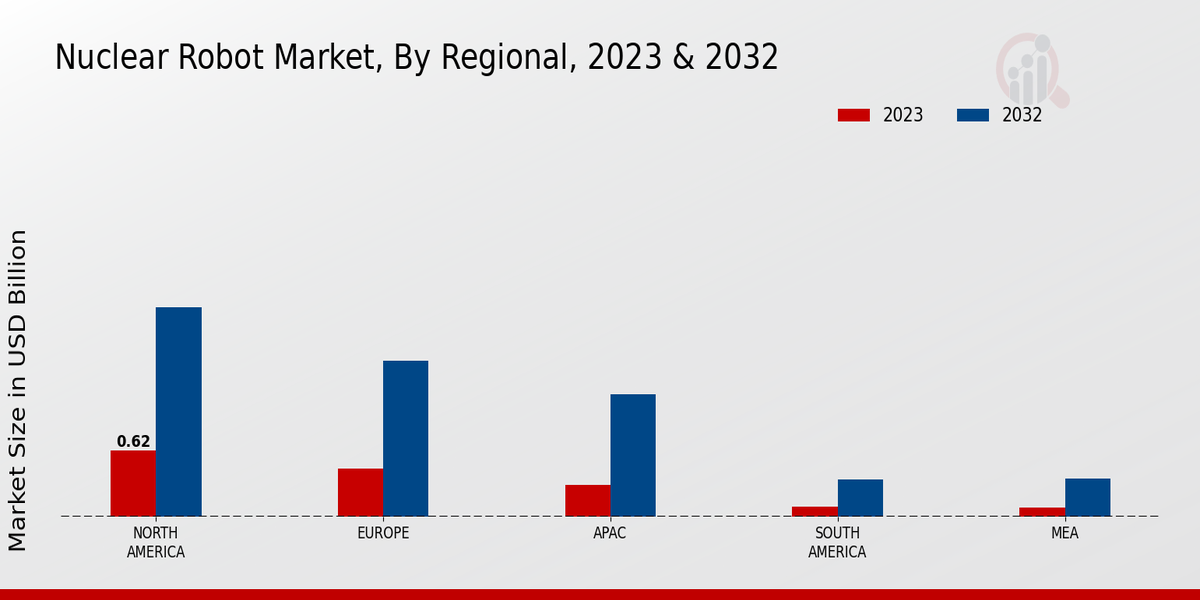Market Growth Projections
The Global Nuclear Robot Market Industry is characterized by robust growth projections, with estimates indicating a rise from 3.25 USD Billion in 2024 to 7.5 USD Billion by 2035. This growth trajectory suggests a compound annual growth rate (CAGR) of 7.9% from 2025 to 2035. Such figures reflect the increasing adoption of robotic technologies across various nuclear applications, including maintenance, inspection, and decommissioning. The market's expansion is likely driven by advancements in technology, regulatory support, and the growing emphasis on safety and efficiency in nuclear operations. As the industry continues to evolve, these projections underscore the potential for significant investment and innovation in nuclear robotics.
Regulatory Support and Investment
Regulatory frameworks and government investments play a crucial role in shaping the Global Nuclear Robot Market Industry. Governments worldwide are increasingly recognizing the importance of robotics in enhancing nuclear safety and efficiency. For example, initiatives aimed at modernizing nuclear facilities often include funding for robotic technologies. This support not only fosters innovation but also encourages private sector investment in the development of nuclear robots. As the market matures, the anticipated growth to 7.5 USD Billion by 2035 underscores the potential for regulatory backing to drive advancements in robotic applications within the nuclear industry.
Technological Advancements in Robotics
Technological advancements significantly influence the Global Nuclear Robot Market Industry, as innovations in robotics enhance capabilities and applications. Developments in artificial intelligence, machine learning, and sensor technologies enable robots to perform complex tasks with greater precision and autonomy. For instance, autonomous drones are increasingly used for aerial inspections of nuclear plants, providing real-time data and reducing downtime. The market is expected to grow at a CAGR of 7.9% from 2025 to 2035, indicating a robust trajectory driven by these technological improvements. As these advancements continue, they are likely to expand the scope of robotic applications within the nuclear sector.
Global Focus on Nuclear Energy Expansion
The Global Nuclear Robot Market Industry is poised for growth due to the global focus on expanding nuclear energy as a sustainable power source. As countries seek to reduce carbon emissions, nuclear energy is increasingly viewed as a viable alternative. This shift necessitates the modernization of existing nuclear facilities, where robots can play a vital role in upgrading infrastructure and ensuring operational efficiency. The projected market growth to 7.5 USD Billion by 2035 reflects the increasing reliance on robotics to support the expansion of nuclear energy. Consequently, the integration of robotic technologies is likely to become a cornerstone of future nuclear energy strategies.
Growing Need for Decommissioning Services
The Global Nuclear Robot Market Industry is significantly influenced by the growing need for decommissioning services as aging nuclear facilities reach the end of their operational life. Decommissioning involves complex processes that require specialized skills and equipment, where robots can enhance safety and efficiency. The use of robotic systems in decommissioning tasks minimizes human exposure to hazardous materials and streamlines operations. As the market evolves, the demand for robotic solutions in decommissioning is expected to rise, contributing to the overall market growth. This trend aligns with the projected increase to 7.5 USD Billion by 2035, highlighting the importance of robotics in managing nuclear waste.
Increasing Demand for Safety and Efficiency
The Global Nuclear Robot Market Industry experiences a rising demand for enhanced safety and operational efficiency in nuclear facilities. Robots are increasingly utilized for tasks such as inspection, maintenance, and decommissioning, which reduces human exposure to radiation. This trend is particularly evident in countries with aging nuclear infrastructure, where robotic solutions are employed to mitigate risks. The market is projected to reach 3.25 USD Billion in 2024, reflecting a growing recognition of the need for advanced technologies in hazardous environments. As the industry evolves, the integration of robotics is likely to play a pivotal role in ensuring safer nuclear operations.





